Healthcare Service Analysis: Aboriginal and Torres Strait Islanders
VerifiedAdded on 2023/02/01
|8
|1659
|66
Report
AI Summary
This report provides an in-depth analysis of healthcare services, specifically focusing on the health conditions of Torres Islanders and Indigenous Australians. It examines the role of healthcare services, such as the 'Deadly Choices' program by Danila Dilba Health Service, in addressing deteriorating health conditions. The report discusses the program's aim to empower Indigenous Australians to make healthy lifestyle choices and prevent chronic illnesses. It also highlights external factors, including mortality and morbidity rates, reduced life expectancy, and barriers to accessing mainstream healthcare services, such as racism and poor communication. The report further explores healthcare practices, including traditional medicine and cultural practices, and concludes by emphasizing the importance of addressing health disparities and improving healthcare access for Indigenous populations. The report references multiple sources to support its findings.
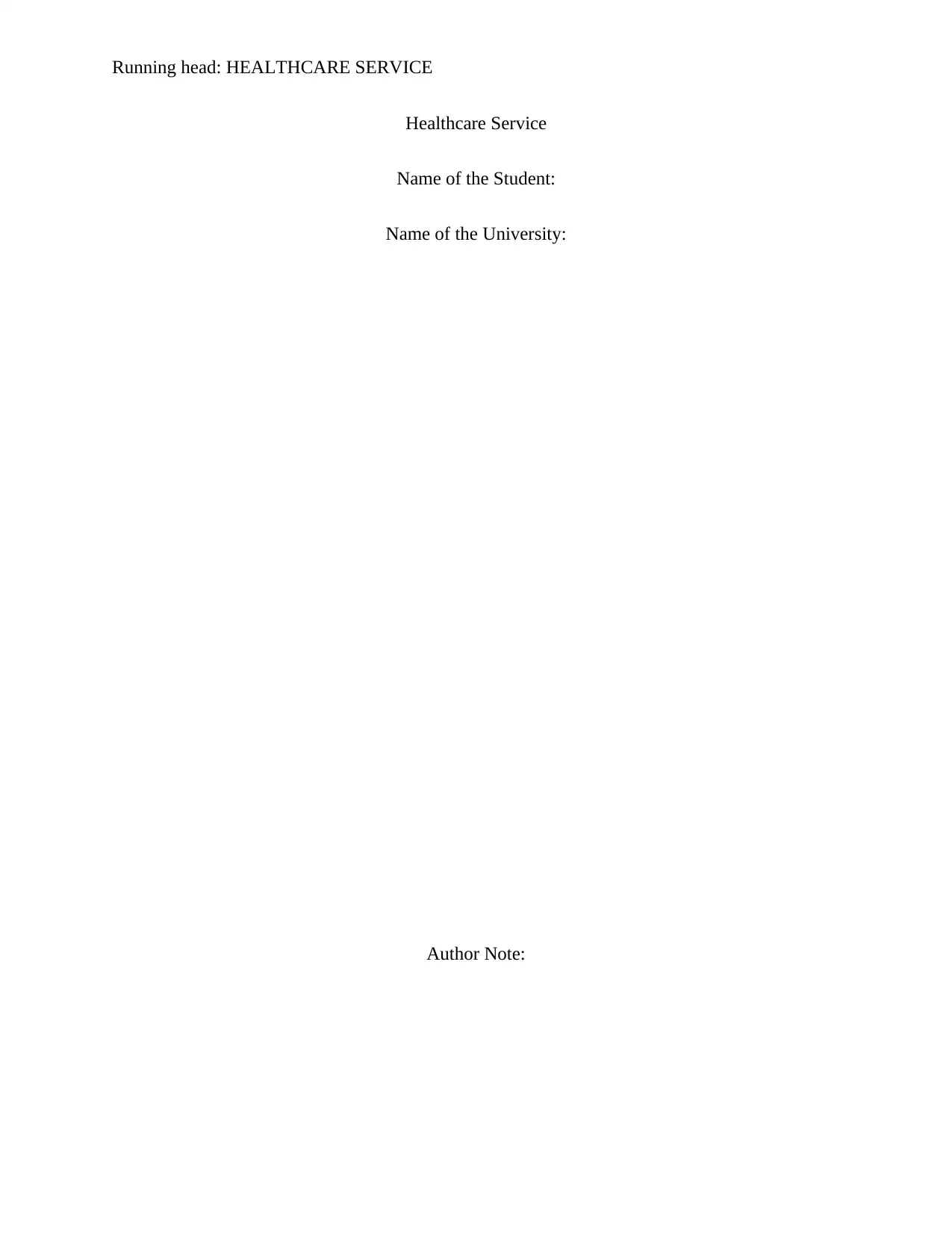
Running head: HEALTHCARE SERVICE
Healthcare Service
Name of the Student:
Name of the University:
Author Note:
Healthcare Service
Name of the Student:
Name of the University:
Author Note:
Paraphrase This Document
Need a fresh take? Get an instant paraphrase of this document with our AI Paraphraser
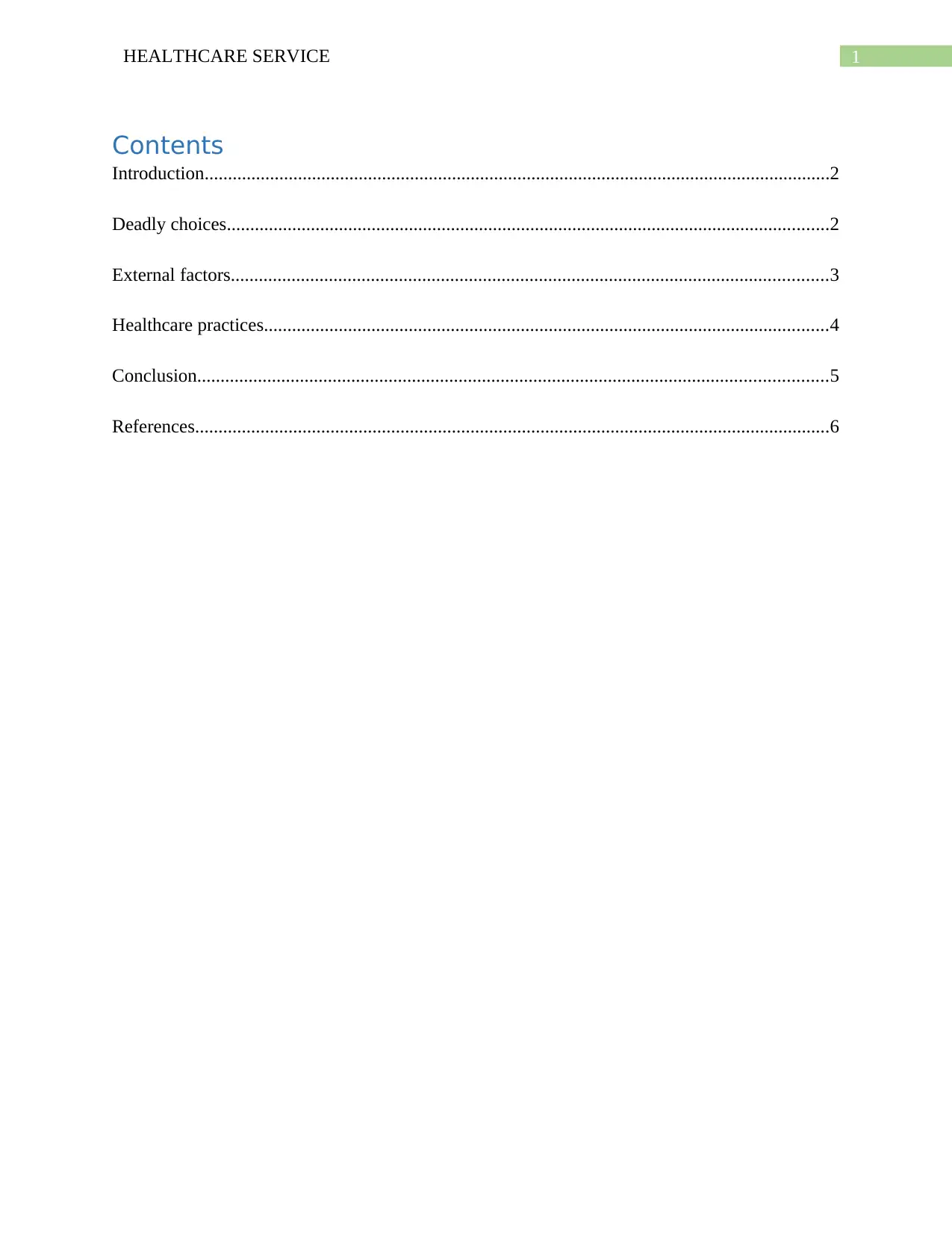
1HEALTHCARE SERVICE
Contents
Introduction......................................................................................................................................2
Deadly choices.................................................................................................................................2
External factors................................................................................................................................3
Healthcare practices.........................................................................................................................4
Conclusion.......................................................................................................................................5
References........................................................................................................................................6
Contents
Introduction......................................................................................................................................2
Deadly choices.................................................................................................................................2
External factors................................................................................................................................3
Healthcare practices.........................................................................................................................4
Conclusion.......................................................................................................................................5
References........................................................................................................................................6
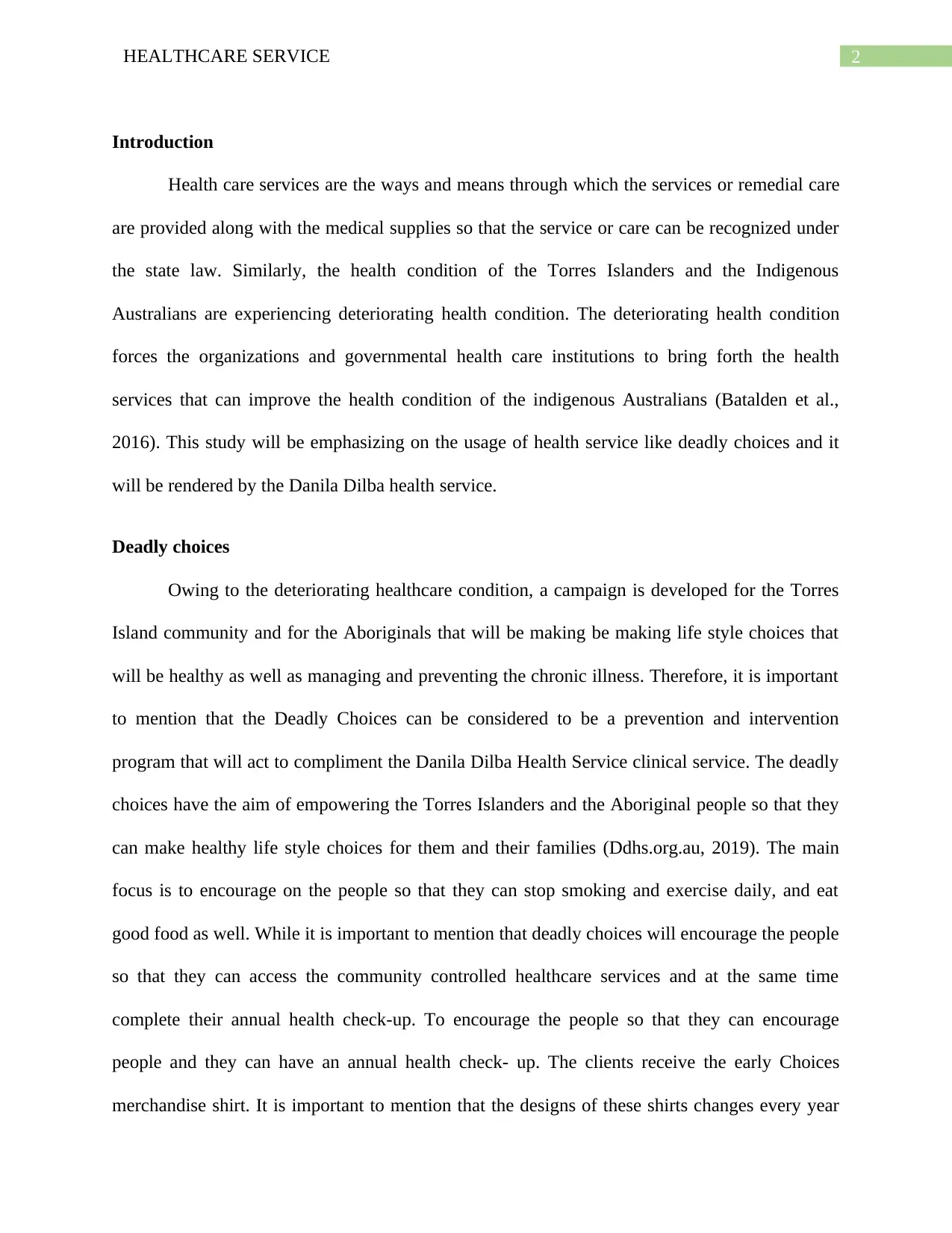
2HEALTHCARE SERVICE
Introduction
Health care services are the ways and means through which the services or remedial care
are provided along with the medical supplies so that the service or care can be recognized under
the state law. Similarly, the health condition of the Torres Islanders and the Indigenous
Australians are experiencing deteriorating health condition. The deteriorating health condition
forces the organizations and governmental health care institutions to bring forth the health
services that can improve the health condition of the indigenous Australians (Batalden et al.,
2016). This study will be emphasizing on the usage of health service like deadly choices and it
will be rendered by the Danila Dilba health service.
Deadly choices
Owing to the deteriorating healthcare condition, a campaign is developed for the Torres
Island community and for the Aboriginals that will be making be making life style choices that
will be healthy as well as managing and preventing the chronic illness. Therefore, it is important
to mention that the Deadly Choices can be considered to be a prevention and intervention
program that will act to compliment the Danila Dilba Health Service clinical service. The deadly
choices have the aim of empowering the Torres Islanders and the Aboriginal people so that they
can make healthy life style choices for them and their families (Ddhs.org.au, 2019). The main
focus is to encourage on the people so that they can stop smoking and exercise daily, and eat
good food as well. While it is important to mention that deadly choices will encourage the people
so that they can access the community controlled healthcare services and at the same time
complete their annual health check-up. To encourage the people so that they can encourage
people and they can have an annual health check- up. The clients receive the early Choices
merchandise shirt. It is important to mention that the designs of these shirts changes every year
Introduction
Health care services are the ways and means through which the services or remedial care
are provided along with the medical supplies so that the service or care can be recognized under
the state law. Similarly, the health condition of the Torres Islanders and the Indigenous
Australians are experiencing deteriorating health condition. The deteriorating health condition
forces the organizations and governmental health care institutions to bring forth the health
services that can improve the health condition of the indigenous Australians (Batalden et al.,
2016). This study will be emphasizing on the usage of health service like deadly choices and it
will be rendered by the Danila Dilba health service.
Deadly choices
Owing to the deteriorating healthcare condition, a campaign is developed for the Torres
Island community and for the Aboriginals that will be making be making life style choices that
will be healthy as well as managing and preventing the chronic illness. Therefore, it is important
to mention that the Deadly Choices can be considered to be a prevention and intervention
program that will act to compliment the Danila Dilba Health Service clinical service. The deadly
choices have the aim of empowering the Torres Islanders and the Aboriginal people so that they
can make healthy life style choices for them and their families (Ddhs.org.au, 2019). The main
focus is to encourage on the people so that they can stop smoking and exercise daily, and eat
good food as well. While it is important to mention that deadly choices will encourage the people
so that they can access the community controlled healthcare services and at the same time
complete their annual health check-up. To encourage the people so that they can encourage
people and they can have an annual health check- up. The clients receive the early Choices
merchandise shirt. It is important to mention that the designs of these shirts changes every year
⊘ This is a preview!⊘
Do you want full access?
Subscribe today to unlock all pages.

Trusted by 1+ million students worldwide
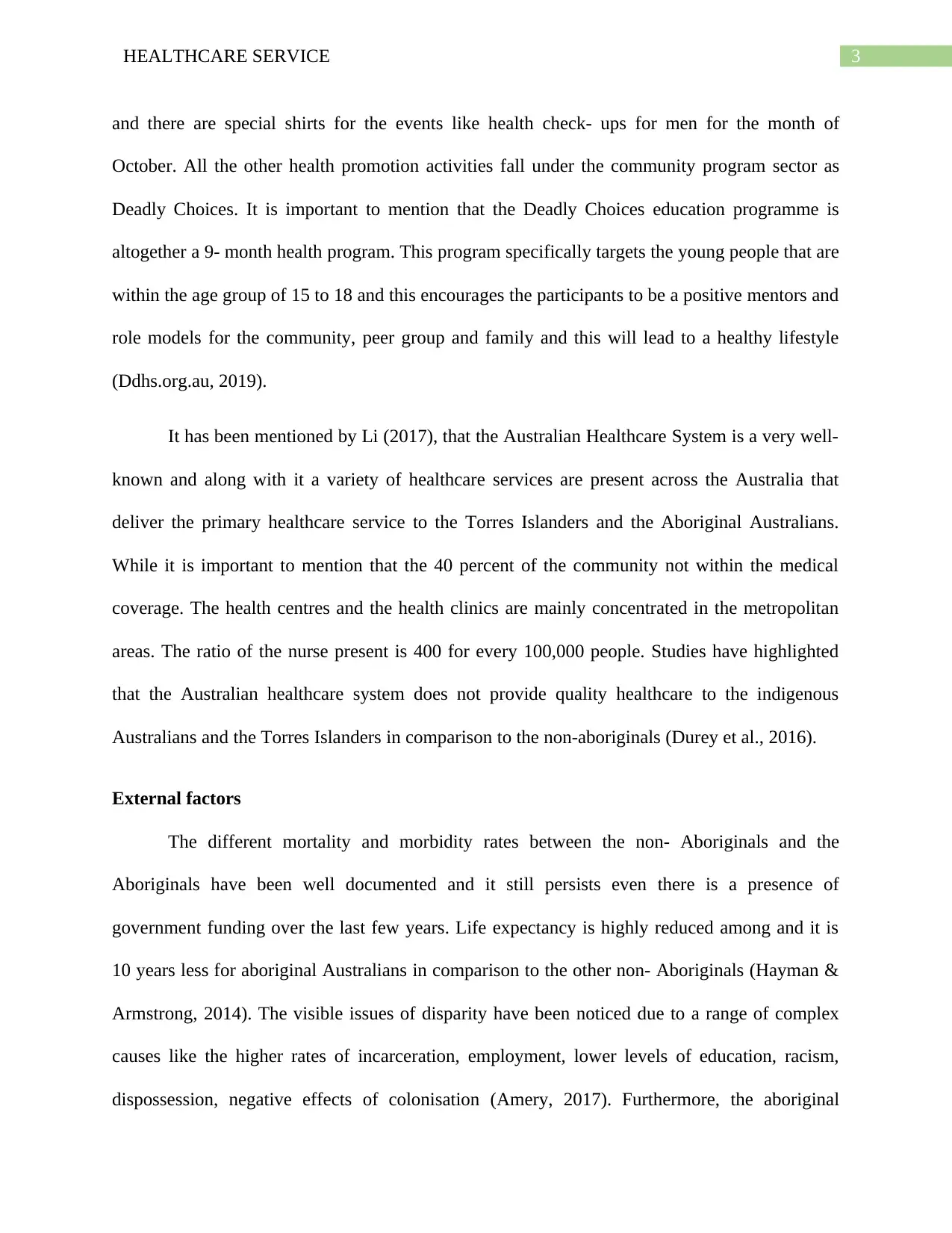
3HEALTHCARE SERVICE
and there are special shirts for the events like health check- ups for men for the month of
October. All the other health promotion activities fall under the community program sector as
Deadly Choices. It is important to mention that the Deadly Choices education programme is
altogether a 9- month health program. This program specifically targets the young people that are
within the age group of 15 to 18 and this encourages the participants to be a positive mentors and
role models for the community, peer group and family and this will lead to a healthy lifestyle
(Ddhs.org.au, 2019).
It has been mentioned by Li (2017), that the Australian Healthcare System is a very well-
known and along with it a variety of healthcare services are present across the Australia that
deliver the primary healthcare service to the Torres Islanders and the Aboriginal Australians.
While it is important to mention that the 40 percent of the community not within the medical
coverage. The health centres and the health clinics are mainly concentrated in the metropolitan
areas. The ratio of the nurse present is 400 for every 100,000 people. Studies have highlighted
that the Australian healthcare system does not provide quality healthcare to the indigenous
Australians and the Torres Islanders in comparison to the non-aboriginals (Durey et al., 2016).
External factors
The different mortality and morbidity rates between the non- Aboriginals and the
Aboriginals have been well documented and it still persists even there is a presence of
government funding over the last few years. Life expectancy is highly reduced among and it is
10 years less for aboriginal Australians in comparison to the other non- Aboriginals (Hayman &
Armstrong, 2014). The visible issues of disparity have been noticed due to a range of complex
causes like the higher rates of incarceration, employment, lower levels of education, racism,
dispossession, negative effects of colonisation (Amery, 2017). Furthermore, the aboriginal
and there are special shirts for the events like health check- ups for men for the month of
October. All the other health promotion activities fall under the community program sector as
Deadly Choices. It is important to mention that the Deadly Choices education programme is
altogether a 9- month health program. This program specifically targets the young people that are
within the age group of 15 to 18 and this encourages the participants to be a positive mentors and
role models for the community, peer group and family and this will lead to a healthy lifestyle
(Ddhs.org.au, 2019).
It has been mentioned by Li (2017), that the Australian Healthcare System is a very well-
known and along with it a variety of healthcare services are present across the Australia that
deliver the primary healthcare service to the Torres Islanders and the Aboriginal Australians.
While it is important to mention that the 40 percent of the community not within the medical
coverage. The health centres and the health clinics are mainly concentrated in the metropolitan
areas. The ratio of the nurse present is 400 for every 100,000 people. Studies have highlighted
that the Australian healthcare system does not provide quality healthcare to the indigenous
Australians and the Torres Islanders in comparison to the non-aboriginals (Durey et al., 2016).
External factors
The different mortality and morbidity rates between the non- Aboriginals and the
Aboriginals have been well documented and it still persists even there is a presence of
government funding over the last few years. Life expectancy is highly reduced among and it is
10 years less for aboriginal Australians in comparison to the other non- Aboriginals (Hayman &
Armstrong, 2014). The visible issues of disparity have been noticed due to a range of complex
causes like the higher rates of incarceration, employment, lower levels of education, racism,
dispossession, negative effects of colonisation (Amery, 2017). Furthermore, the aboriginal
Paraphrase This Document
Need a fresh take? Get an instant paraphrase of this document with our AI Paraphraser
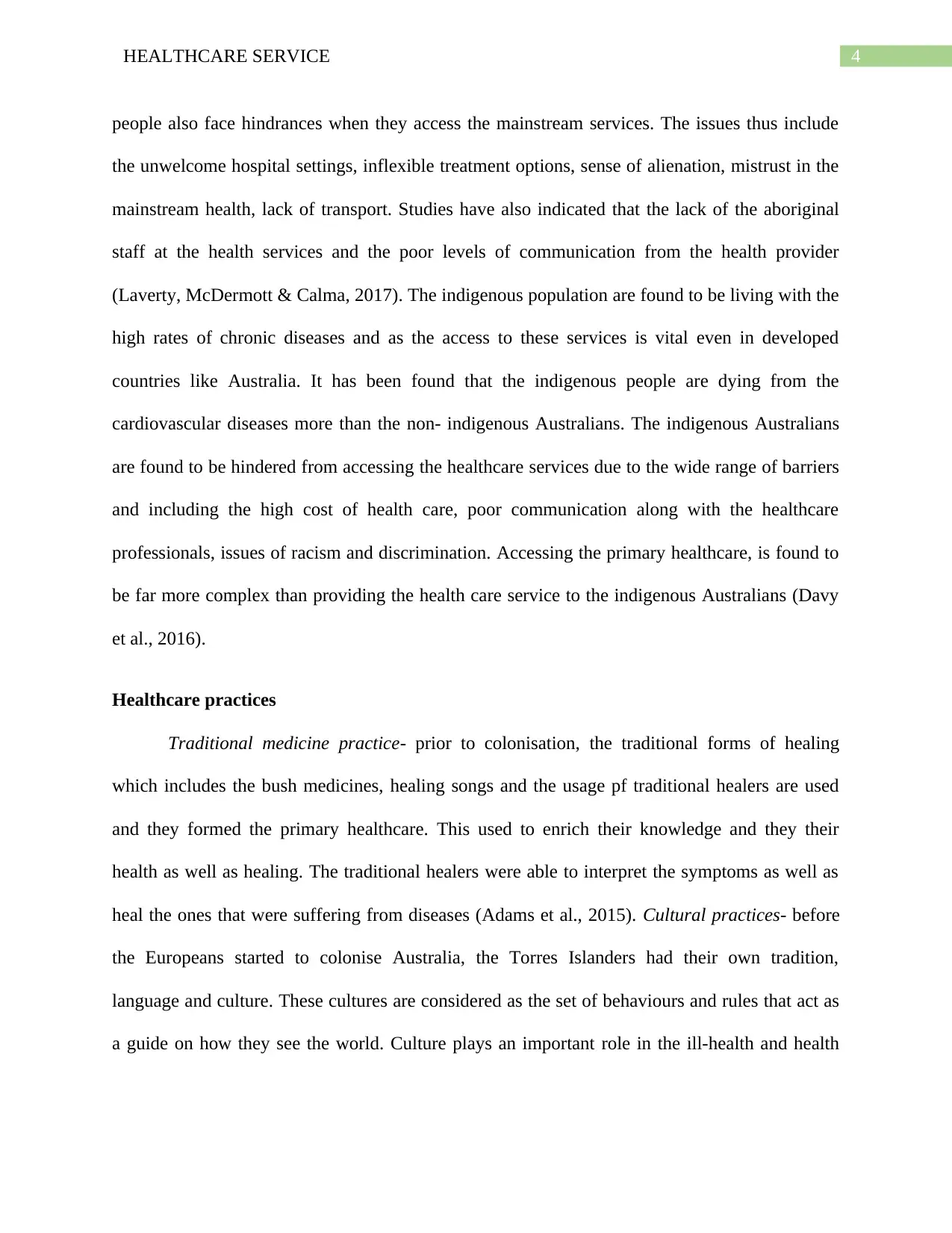
4HEALTHCARE SERVICE
people also face hindrances when they access the mainstream services. The issues thus include
the unwelcome hospital settings, inflexible treatment options, sense of alienation, mistrust in the
mainstream health, lack of transport. Studies have also indicated that the lack of the aboriginal
staff at the health services and the poor levels of communication from the health provider
(Laverty, McDermott & Calma, 2017). The indigenous population are found to be living with the
high rates of chronic diseases and as the access to these services is vital even in developed
countries like Australia. It has been found that the indigenous people are dying from the
cardiovascular diseases more than the non- indigenous Australians. The indigenous Australians
are found to be hindered from accessing the healthcare services due to the wide range of barriers
and including the high cost of health care, poor communication along with the healthcare
professionals, issues of racism and discrimination. Accessing the primary healthcare, is found to
be far more complex than providing the health care service to the indigenous Australians (Davy
et al., 2016).
Healthcare practices
Traditional medicine practice- prior to colonisation, the traditional forms of healing
which includes the bush medicines, healing songs and the usage pf traditional healers are used
and they formed the primary healthcare. This used to enrich their knowledge and they their
health as well as healing. The traditional healers were able to interpret the symptoms as well as
heal the ones that were suffering from diseases (Adams et al., 2015). Cultural practices- before
the Europeans started to colonise Australia, the Torres Islanders had their own tradition,
language and culture. These cultures are considered as the set of behaviours and rules that act as
a guide on how they see the world. Culture plays an important role in the ill-health and health
people also face hindrances when they access the mainstream services. The issues thus include
the unwelcome hospital settings, inflexible treatment options, sense of alienation, mistrust in the
mainstream health, lack of transport. Studies have also indicated that the lack of the aboriginal
staff at the health services and the poor levels of communication from the health provider
(Laverty, McDermott & Calma, 2017). The indigenous population are found to be living with the
high rates of chronic diseases and as the access to these services is vital even in developed
countries like Australia. It has been found that the indigenous people are dying from the
cardiovascular diseases more than the non- indigenous Australians. The indigenous Australians
are found to be hindered from accessing the healthcare services due to the wide range of barriers
and including the high cost of health care, poor communication along with the healthcare
professionals, issues of racism and discrimination. Accessing the primary healthcare, is found to
be far more complex than providing the health care service to the indigenous Australians (Davy
et al., 2016).
Healthcare practices
Traditional medicine practice- prior to colonisation, the traditional forms of healing
which includes the bush medicines, healing songs and the usage pf traditional healers are used
and they formed the primary healthcare. This used to enrich their knowledge and they their
health as well as healing. The traditional healers were able to interpret the symptoms as well as
heal the ones that were suffering from diseases (Adams et al., 2015). Cultural practices- before
the Europeans started to colonise Australia, the Torres Islanders had their own tradition,
language and culture. These cultures are considered as the set of behaviours and rules that act as
a guide on how they see the world. Culture plays an important role in the ill-health and health
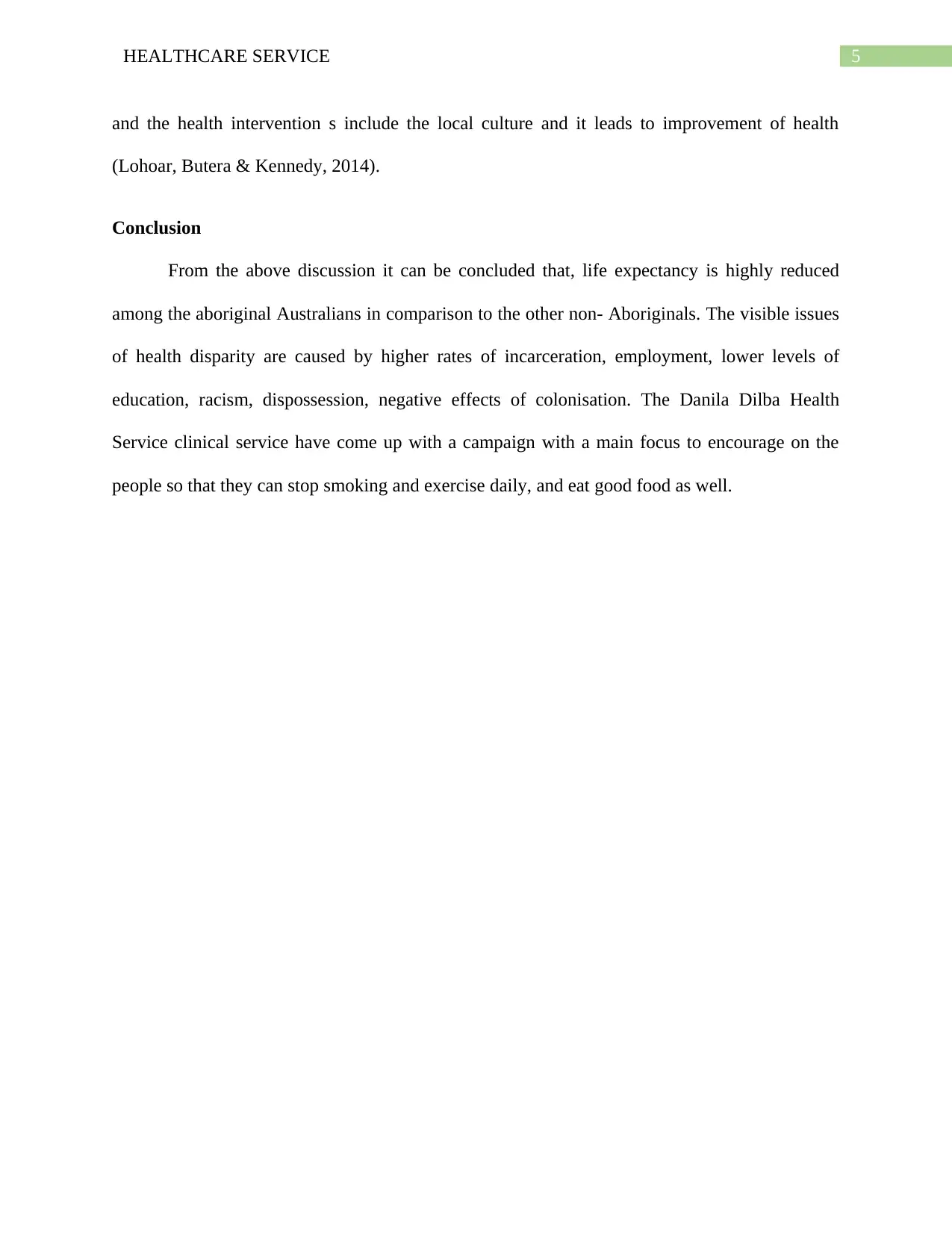
5HEALTHCARE SERVICE
and the health intervention s include the local culture and it leads to improvement of health
(Lohoar, Butera & Kennedy, 2014).
Conclusion
From the above discussion it can be concluded that, life expectancy is highly reduced
among the aboriginal Australians in comparison to the other non- Aboriginals. The visible issues
of health disparity are caused by higher rates of incarceration, employment, lower levels of
education, racism, dispossession, negative effects of colonisation. The Danila Dilba Health
Service clinical service have come up with a campaign with a main focus to encourage on the
people so that they can stop smoking and exercise daily, and eat good food as well.
and the health intervention s include the local culture and it leads to improvement of health
(Lohoar, Butera & Kennedy, 2014).
Conclusion
From the above discussion it can be concluded that, life expectancy is highly reduced
among the aboriginal Australians in comparison to the other non- Aboriginals. The visible issues
of health disparity are caused by higher rates of incarceration, employment, lower levels of
education, racism, dispossession, negative effects of colonisation. The Danila Dilba Health
Service clinical service have come up with a campaign with a main focus to encourage on the
people so that they can stop smoking and exercise daily, and eat good food as well.
⊘ This is a preview!⊘
Do you want full access?
Subscribe today to unlock all pages.

Trusted by 1+ million students worldwide
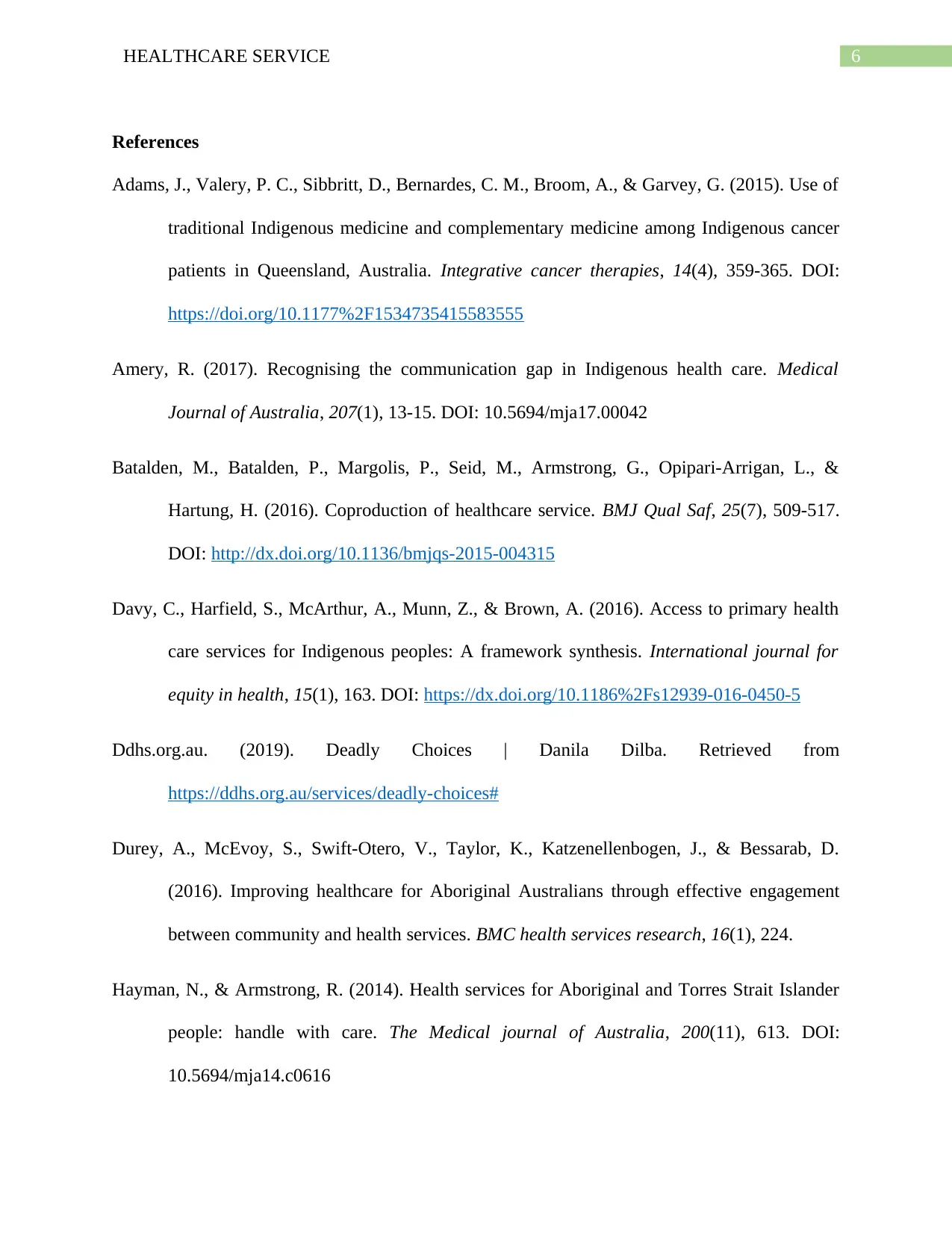
6HEALTHCARE SERVICE
References
Adams, J., Valery, P. C., Sibbritt, D., Bernardes, C. M., Broom, A., & Garvey, G. (2015). Use of
traditional Indigenous medicine and complementary medicine among Indigenous cancer
patients in Queensland, Australia. Integrative cancer therapies, 14(4), 359-365. DOI:
https://doi.org/10.1177%2F1534735415583555
Amery, R. (2017). Recognising the communication gap in Indigenous health care. Medical
Journal of Australia, 207(1), 13-15. DOI: 10.5694/mja17.00042
Batalden, M., Batalden, P., Margolis, P., Seid, M., Armstrong, G., Opipari-Arrigan, L., &
Hartung, H. (2016). Coproduction of healthcare service. BMJ Qual Saf, 25(7), 509-517.
DOI: http://dx.doi.org/10.1136/bmjqs-2015-004315
Davy, C., Harfield, S., McArthur, A., Munn, Z., & Brown, A. (2016). Access to primary health
care services for Indigenous peoples: A framework synthesis. International journal for
equity in health, 15(1), 163. DOI: https://dx.doi.org/10.1186%2Fs12939-016-0450-5
Ddhs.org.au. (2019). Deadly Choices | Danila Dilba. Retrieved from
https://ddhs.org.au/services/deadly-choices#
Durey, A., McEvoy, S., Swift-Otero, V., Taylor, K., Katzenellenbogen, J., & Bessarab, D.
(2016). Improving healthcare for Aboriginal Australians through effective engagement
between community and health services. BMC health services research, 16(1), 224.
Hayman, N., & Armstrong, R. (2014). Health services for Aboriginal and Torres Strait Islander
people: handle with care. The Medical journal of Australia, 200(11), 613. DOI:
10.5694/mja14.c0616
References
Adams, J., Valery, P. C., Sibbritt, D., Bernardes, C. M., Broom, A., & Garvey, G. (2015). Use of
traditional Indigenous medicine and complementary medicine among Indigenous cancer
patients in Queensland, Australia. Integrative cancer therapies, 14(4), 359-365. DOI:
https://doi.org/10.1177%2F1534735415583555
Amery, R. (2017). Recognising the communication gap in Indigenous health care. Medical
Journal of Australia, 207(1), 13-15. DOI: 10.5694/mja17.00042
Batalden, M., Batalden, P., Margolis, P., Seid, M., Armstrong, G., Opipari-Arrigan, L., &
Hartung, H. (2016). Coproduction of healthcare service. BMJ Qual Saf, 25(7), 509-517.
DOI: http://dx.doi.org/10.1136/bmjqs-2015-004315
Davy, C., Harfield, S., McArthur, A., Munn, Z., & Brown, A. (2016). Access to primary health
care services for Indigenous peoples: A framework synthesis. International journal for
equity in health, 15(1), 163. DOI: https://dx.doi.org/10.1186%2Fs12939-016-0450-5
Ddhs.org.au. (2019). Deadly Choices | Danila Dilba. Retrieved from
https://ddhs.org.au/services/deadly-choices#
Durey, A., McEvoy, S., Swift-Otero, V., Taylor, K., Katzenellenbogen, J., & Bessarab, D.
(2016). Improving healthcare for Aboriginal Australians through effective engagement
between community and health services. BMC health services research, 16(1), 224.
Hayman, N., & Armstrong, R. (2014). Health services for Aboriginal and Torres Strait Islander
people: handle with care. The Medical journal of Australia, 200(11), 613. DOI:
10.5694/mja14.c0616
Paraphrase This Document
Need a fresh take? Get an instant paraphrase of this document with our AI Paraphraser
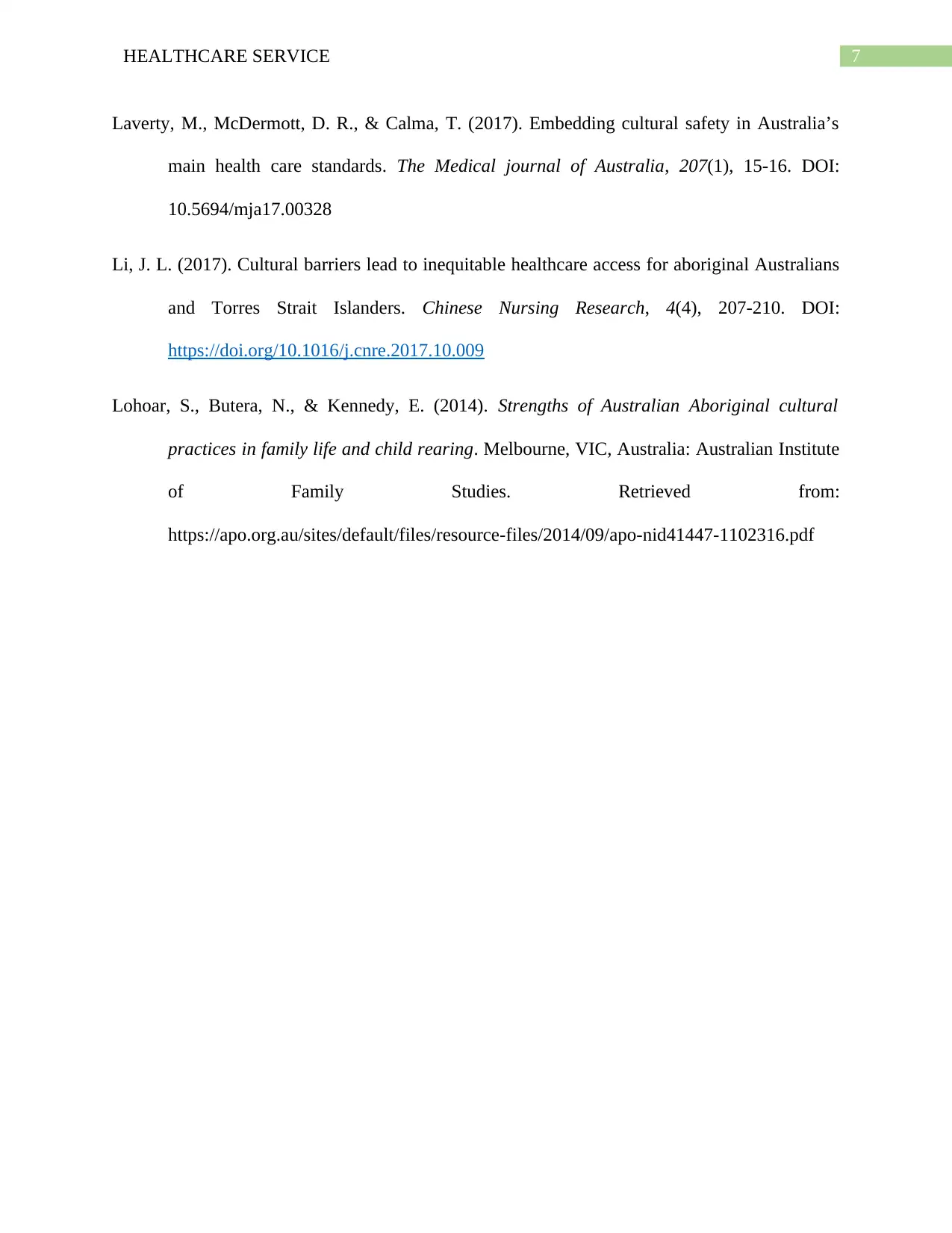
7HEALTHCARE SERVICE
Laverty, M., McDermott, D. R., & Calma, T. (2017). Embedding cultural safety in Australia’s
main health care standards. The Medical journal of Australia, 207(1), 15-16. DOI:
10.5694/mja17.00328
Li, J. L. (2017). Cultural barriers lead to inequitable healthcare access for aboriginal Australians
and Torres Strait Islanders. Chinese Nursing Research, 4(4), 207-210. DOI:
https://doi.org/10.1016/j.cnre.2017.10.009
Lohoar, S., Butera, N., & Kennedy, E. (2014). Strengths of Australian Aboriginal cultural
practices in family life and child rearing. Melbourne, VIC, Australia: Australian Institute
of Family Studies. Retrieved from:
https://apo.org.au/sites/default/files/resource-files/2014/09/apo-nid41447-1102316.pdf
Laverty, M., McDermott, D. R., & Calma, T. (2017). Embedding cultural safety in Australia’s
main health care standards. The Medical journal of Australia, 207(1), 15-16. DOI:
10.5694/mja17.00328
Li, J. L. (2017). Cultural barriers lead to inequitable healthcare access for aboriginal Australians
and Torres Strait Islanders. Chinese Nursing Research, 4(4), 207-210. DOI:
https://doi.org/10.1016/j.cnre.2017.10.009
Lohoar, S., Butera, N., & Kennedy, E. (2014). Strengths of Australian Aboriginal cultural
practices in family life and child rearing. Melbourne, VIC, Australia: Australian Institute
of Family Studies. Retrieved from:
https://apo.org.au/sites/default/files/resource-files/2014/09/apo-nid41447-1102316.pdf
1 out of 8
Related Documents
Your All-in-One AI-Powered Toolkit for Academic Success.
+13062052269
info@desklib.com
Available 24*7 on WhatsApp / Email
![[object Object]](/_next/static/media/star-bottom.7253800d.svg)
Unlock your academic potential
Copyright © 2020–2025 A2Z Services. All Rights Reserved. Developed and managed by ZUCOL.





